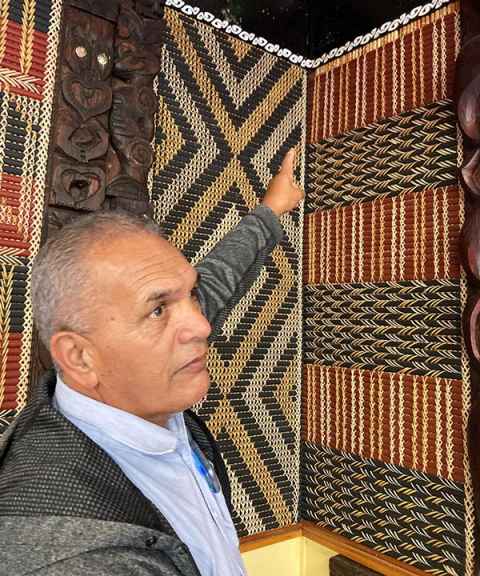A Matariki story from Epsom Campus marae
5 July 2023
In the 1980s, teacher trainee Moutini Bryers made a significant contribution to the Māori celestial knowledge held within the wharenui at Epsom Campus, write Rose Yukich and Hēmi Dale.

In 1983, long before the prospect of a new public holiday alerted many of us to the presence of Matariki in the night sky, young teacher trainee Moutini Bryers (Ngāpuhi, Te Mahurehure) embarked on research into the stars that would become part of the fabric of Tūtahi Tonu, the wharenui at Epsom Campus.
Moutini and partner Patsy Bryers (Ngāti Kurī) visited the Epsom Campus in April as part of the Marae History Project, sponsored by the Faculty of Education and Social Work, which is gathering stories about the creation of wharenui Tūtahi Tonu before its shift to the City Campus in November.
The daunting task assigned to Moutini was instigated by Tarutaru Rankin (Ngāpuhi), head of Māori Studies in the early 1980s and the driving force behind establishing a marae at the then Auckland Teachers Training College.
“When it came to the work that had to be done in the new whare, Taru dished out all the jobs,” recalls Moutini. “He went through the boys, then the girls, and right at the end he said to me that I was to go and do research about the important stars in my life.”
Making an auspicious start during the season of Matariki itself, he carried out the study over several months from a small shed erected especially for him close to the wharenui.
“My only contact was with Taru and Patsy. She would come at night to cook my dinner. I think the work connected me to the tupuna but, looking back, I barely touched the surface. We know so much more now.”
The end result of his solitary labours was a series of panels depicting ‘Te Whānau Mārama’ – the family of light or celestial bodies – that included ngā whetū (the stars) and the Māori lunar calendar (maramataka). These panels run the length of Tūtahi Tonu’s back wall, just below the ceiling resting above and beside tukutuku weaving and carved pou.

Moutini’s research unearthed unexpected discoveries about his whakapapa and Māori identity.
“From my reading a particular name jumped out at me – a man who was an expert tohunga on the stars in the Northern region. I rang my mother to ask about him, and she said, ‘Oh that’s your great-great grandfather.’ Later Taru put me in touch with one of my relatives who told me that the kind of mahi I was doing hadn’t been done in our family for three generations.”
Moutini’s initial motivation to apply for teacher training was sparked by rumours of a New Zealand teachers’ rugby side, the game being one of his passions. Once enrolled, he expected his subjects to be physical education and mathematics, but an encounter with Taru during his first days on campus propelled him in another direction.
“I was walking along, heading for Mt Eden, when this big guy sitting near the whare called me over. He knew my family and used the name ‘Moutini’ to address me. Up until then I had only ever been ‘Martin’.
"My siblings and I were given Māori names but on our birth certificates it’s all English names. My parents were fluent in the reo but we never heard them speak it. All those years I was Martin but now I was thinking, what would I be like if I was a Moutini as well? It was Taru who started me down that path. It was as if he knew more about me than I did myself.”
Overnight his main subject became Māori Studies and it remained the centre of his studies for the next three years. Both he and Patsy credit Taru for impressing upon them and many other students the importance of Māori knowledge, and the need to reclaim it. Taru’s influence and the experience of contributing to Tūtahi Tonu laid the foundations for their long and successful careers in education.

Complementing Moutini’s panels on the inside of the wharenui is a carving that adorns an outside edge of Tūtahi Tonu’s mahau (porch). Called ‘Te Kāhui o Matariki’ (the Matariki constellation), it was created by the whare’s lead carver Mark Klaricich.
“Where things are in the whare had a reason,” says Moutini, “Taru had a reason. The entirety of the space is meant to be together. You can’t leave any chapters out in the shift.”
The Epsom Campus marae begins the process of moving to the City Campus after its 40th anniversary celebrations in late November. If readers have archival material (images or documents) that may be helpful for the Marae History Project, please contact: Hēmi Dale on hemi.dale@auckland.ac.nz or Rose Yukich on r.yukich@auckland.ac.nz.

Media contact
Julianne Evans | Media adviser
M: 027 562 5868
E: julianne.evans@auckland.ac.nz